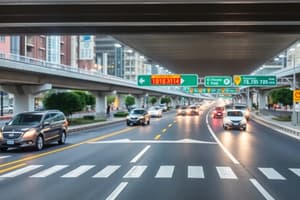Podcast
Questions and Answers
What does accessibility in transportation refer to?
What does accessibility in transportation refer to?
- The effectiveness of transportation strategies.
- The cost of getting to and from a location. (correct)
- The speed of travel time for different modes.
- The amount of goods transported per unit time.
Which mode of transportation offers the highest line-haul speed?
Which mode of transportation offers the highest line-haul speed?
- Highways
- Rail
- Water
- Air (correct)
What is the most dominant transportation mode within modern society?
What is the most dominant transportation mode within modern society?
- Air transportation
- Water transportation
- Highways (correct)
- Rail transportation
Which of the following components is not part of the transportation system?
Which of the following components is not part of the transportation system?
What is a significant drawback of the rail system in terms of travel time?
What is a significant drawback of the rail system in terms of travel time?
The effectiveness of a transportation system can be measured by which of the following?
The effectiveness of a transportation system can be measured by which of the following?
Which aspect of water transportation presents a significant environmental concern?
Which aspect of water transportation presents a significant environmental concern?
Which mode of transportation has significant environmental impacts, especially related to air pollution?
Which mode of transportation has significant environmental impacts, especially related to air pollution?
What advantage does road transport have over other modes of transportation?
What advantage does road transport have over other modes of transportation?
Which of the following best describes productivity in transportation?
Which of the following best describes productivity in transportation?
Which of the following is NOT an aspect of highway engineering?
Which of the following is NOT an aspect of highway engineering?
What is one of the major drawbacks of air transportation?
What is one of the major drawbacks of air transportation?
What is a characteristic of the domestic water transportation system?
What is a characteristic of the domestic water transportation system?
Flashcards are hidden until you start studying
Study Notes
Transportation Engineering Overview
- Application of scientific principles for planning, design, operation, and management of transportation systems.
- Major functional system in modern society facilitating the movement of goods and people.
Components of Transportation System
- Physical Facilities: Streets, roads, highways, railroads, airports, sea/river ports, pipelines, canals.
- Fleets: Vehicles, vessels, and aircraft utilized in the system.
- Operating Bases: Includes vehicle maintenance and office facilities.
- Organizations: Comprises facility-oriented and operating organizations.
- Operating Strategies: Involves vehicle routing, scheduling, and traffic control.
Effectiveness of Transportation System
- Accessibility: Affected by geographical expansiveness and costs of travel.
- Mobility: Refers to speed or travel time available for transport.
- Productivity: Measured by transportation output per unit time, considering the volume of goods/passengers and distance traveled.
Modes of Transportation
-
Highways:
- Most dominant mode, high accessibility to destinations.
- Low door-to-door travel time, moderate travel speeds and capacities.
- High environmental impacts, especially air pollution.
-
Air Transportation:
- Comprises commercial airlines, airfreight, and general aviation.
- High line-haul speeds but limited accessibility.
- Moderate capacities; significant capital and operational costs, though high productivity reduces cost per passenger.
- Notable environmental concerns include noise pollution.
-
Rail Transportation:
- Moderate speeds and access levels.
- Traditional practices cause high and unpredictable door-to-door travel times.
- High capital costs for locomotives and track maintenance but relatively low environmental impacts.
-
Water Transportation:
- Involves coastwise ocean shipping and inland waterway barge lines.
- Low speed and accessibility contrasted with high capacity.
- High capital costs for vessels; significant environmental issues including water pollution from routine and accidental discharges.
Scope of Highway Engineering
- Development, planning, and location processes.
- Design considerations for geometrical and structural aspects.
- Traffic performance evaluation and control strategies.
- Involvement in materials, construction, and maintenance practices.
- Focus on economic, financial, and administrative management.
Civil Engineering and Transportation
- Essential role in the design and maintenance of transportation infrastructure.
Characteristics of Road Transport
- High versatility for various vehicle types.
- Requires low government investment compared to other modes.
- Allows complete freedom for road users, especially beneficial for short-distance travel.
- Direct correlation between movement speed and infrastructure quality.
- Unique as the only transport mode that offers itself entirely for use.
Studying That Suits You
Use AI to generate personalized quizzes and flashcards to suit your learning preferences.




